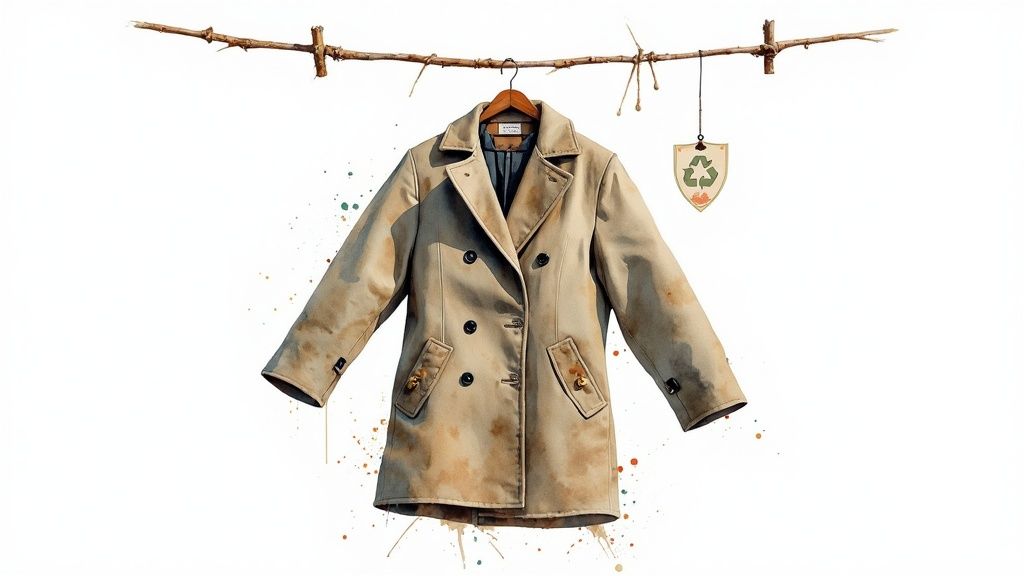The fashion world is undergoing a seismic shift, moving beyond seasonal collections and embracing revolutionary changes driven by technology, sustainability, and evolving consumer values. This isn't just about what's 'in' or 'out' for a season; it's about a fundamental reinvention of how clothing is designed, produced, sold, and experienced. The most impactful fashion industry trends today are not fleeting fads. They represent powerful movements shaping a more intelligent, responsible, and personalized future for apparel and commerce.
For brands, creators, and marketers, understanding these transformations is no longer optional, it's essential for survival and growth. This roundup moves beyond surface-level observations to provide a strategic overview of the 10 developments defining the market. We will explore the practical applications and business implications of everything from digital garments in virtual worlds and AI-driven personalization to the booming circular economy and the rise of wellness-centric apparel.
Get ready to explore the critical innovations that are redefining style, consumption, and connection. This curated list offers actionable insights into the concepts that matter right now, providing a clear roadmap to the future of fashion. The following sections break down each trend, offering a concise yet comprehensive look at what you need to know to stay ahead.
1. Sustainable and Circular Fashion
Among the most transformative fashion industry trends, the shift towards sustainability and circularity represents a fundamental reimagining of production and consumption. This approach moves beyond single-use, fast-fashion models to embrace a comprehensive system focused on environmental responsibility. It prioritizes eco-friendly materials, ethical manufacturing, and circular economy principles designed to eliminate waste and extend the lifespan of every garment.

The core idea is to create a closed-loop system where apparel is worn, resold, repaired, and eventually recycled back into new textiles, minimizing the industry's environmental footprint.
How to Implement Sustainable Practices
Brands can integrate this trend by adopting specific, actionable strategies. For instance, Patagonia's Worn Wear program encourages customers to trade in used gear for store credit, which is then repaired and resold. Similarly, Eileen Fisher’s RENEW program takes back used garments to be resold or remade into new designs, proving that circularity is not just ethical but also profitable.
Actionable Tips for Integration:
- Partner with Certified Suppliers: Collaborate with suppliers certified by organizations like the Global Organic Textile Standard (GOTS) or Fair Trade to ensure material integrity and ethical labor.
- Educate Consumers: Use product tags, social media, and website content to teach customers how to properly care for, repair, and eventually recycle their garments to maximize longevity.
- Implement Take-Back Programs: Start a pilot program for taking back used products. This builds customer loyalty and provides a valuable source of materials for upcycling or recycling initiatives.
2. Digital Fashion and Virtual Clothing
Another of the most disruptive fashion industry trends is the emergence of digital fashion and virtual clothing. This innovative frontier involves designing, creating, and selling apparel that exists only in digital spaces. It represents a powerful convergence of fashion, gaming, and technology, allowing consumers to build and express their identities in virtual worlds, on social media, and through augmented reality without any physical product.

The core concept is to decouple fashion from physical constraints, offering limitless creative possibilities and a new, sustainable way to engage with style. The rise of digital fashion extends to practical applications, allowing consumers to explore new ways of managing their personal style, such as by learning how to make an outfit with a digital wardrobe.
How to Implement Digital Fashion
Brands are successfully entering this space by treating virtual items as legitimate products. For example, Balenciaga’s collaboration with Fortnite introduced digital skins that became highly sought-after status symbols within the game. Similarly, DressX operates as a "metaverse closet," allowing users to purchase digital-only outfits to wear in photos and videos, proving a viable market for virtual self-expression.
Actionable Tips for Integration:
- Partner with Gaming Platforms: Collaborate with popular games like Fortnite or Roblox to create branded skins or accessories, reaching a massive and engaged digital-native audience.
- Develop AR Filters: Start with accessible entry points like branded AR filters for Instagram or Snapchat that allow users to "try on" virtual accessories or makeup.
- Focus on Digital-Only Designs: Leverage the freedom of the digital realm to create fantastical, impossible-in-real-life garments that capture attention and showcase pure creativity.
3. Personalization and Customization
As consumers increasingly seek products that reflect their individual identity, personalization and customization have become pivotal fashion industry trends. This movement leverages technology to shift from mass production to creating unique, one-of-a-kind items and experiences. It encompasses everything from made-to-order services and AI-driven style recommendations to customizable design options, fostering a deeper connection between brands and their customers.

The core principle is to empower the consumer as a co-creator, transforming them from a passive buyer into an active participant in the design process. This not only enhances customer loyalty but also reduces waste by aligning production directly with demand.
How to Implement Personalization and Customization
Leading brands demonstrate how to integrate this trend effectively. The Nike By You platform allows customers to design their own sneakers, choosing colors and materials to create a unique product. Similarly, Indochino has built its entire business model on made-to-measure suiting, offering a perfect fit by collecting individual customer measurements online or in-store. Stitch Fix uses sophisticated AI algorithms and human stylists to curate personalized clothing boxes, learning from customer feedback to refine selections over time.
Actionable Tips for Integration:
- Start with Simple Options: Begin by offering basic customization, such as monogramming or a choice of colors and fabrics, before investing in more complex made-to-order systems.
- Invest in User-Friendly Interfaces: Develop an intuitive and engaging online design tool or interface that makes the customization process simple and enjoyable for the customer.
- Leverage Customer Data: Use data from purchases and customer feedback to refine AI-driven recommendation algorithms, improving the accuracy and appeal of personalized suggestions.
4. Resale and Secondhand Fashion
The rise of resale and secondhand markets is one of the most impactful fashion industry trends, fundamentally altering consumer behavior and the product lifecycle. Driven by a blend of sustainability concerns, value consciousness, and a desire for unique vintage finds, this trend has shifted pre-owned clothing from niche thrift stores to a sophisticated, mainstream marketplace. It encompasses everything from luxury consignment to peer-to-peer selling platforms and brand-operated resale programs.

This model extends the life of garments, offering consumers access to high-end items at a lower price point while promoting a more circular economy. It transforms every shopper into a potential seller, creating a dynamic ecosystem that challenges the traditional linear model of "buy, wear, discard."
How to Implement Resale and Secondhand Models
Brands are increasingly embracing this trend to engage customers and control their brand's narrative in the secondary market. The RealReal and Vestiaire Collective have built massive businesses by authenticating and curating luxury pre-owned goods, creating trust in the space. More impressively, luxury brands like Gucci have partnered directly with The RealReal, acknowledging and legitimizing the resale market as a vital part of the fashion landscape.
Actionable Tips for Integration:
- Launch a Branded Resale Platform: Partner with a white-label resale technology provider like Recurate or Treet to create a brand-owned marketplace. This allows you to capture resale revenue and maintain customer relationships.
- Establish an Authentication Process: For luxury or high-value items, develop a rigorous authentication system to build consumer trust. This can involve in-house experts or partnerships with third-party authenticators.
- Incentivize Trade-Ins: Encourage customers to return their pre-owned items from your brand in exchange for store credit. This drives new sales while supplying inventory for your secondhand channel.
5. Gender-Neutral and Inclusive Fashion
Another of the most significant fashion industry trends is the definitive move away from rigid, traditional norms toward gender-neutral and inclusive design. This evolution reflects a broader societal shift, demanding apparel that serves everyone, regardless of gender identity, body size, or physical ability. It’s about creating clothing that transcends binaries and celebrates diversity in all its forms, from universal silhouettes to adaptive features.
The core principle is to dismantle outdated barriers, offering collections where style, fit, and function are accessible to all. This approach fosters a more welcoming and authentic connection between brands and a diverse consumer base.
How to Implement Inclusive Practices
Brands can successfully integrate this trend by centering the needs of historically underserved communities. For example, Telfar’s iconic unisex bags became a cultural phenomenon by being both aspirational and accessible. Similarly, Universal Standard champions size inclusivity by offering every design in sizes 00 to 40, while Tommy Hilfiger's Adaptive line incorporates features like magnetic closures to make dressing easier for people with disabilities.
Actionable Tips for Integration:
- Feature Diverse Models: Your marketing campaigns should authentically represent the diversity you aim to serve, including various genders, body types, abilities, and ethnicities.
- Use Inclusive Language: Audit all brand communications, from product descriptions to social media posts, to ensure language is neutral and welcoming to everyone.
- Collaborate with Communities: Partner with LGBTQ+ and disability organizations to gain genuine insights and co-create products that meet real-world needs, ensuring your efforts are impactful and respectful.
6. Direct-to-Consumer (DTC) Brands
The rise of Direct-to-Consumer (DTC) brands is one of the most disruptive fashion industry trends, fundamentally altering the relationship between creators and customers. This model involves selling directly to consumers through proprietary channels, bypassing traditional retail intermediaries like department stores. By cutting out the middleman, DTC brands gain complete control over their branding, customer experience, and profit margins, often delivering premium quality at more accessible price points.
This direct line to the consumer allows for unparalleled agility, enabling brands to react swiftly to market feedback and build loyal communities around shared values and transparent practices.
How to Implement a DTC Model
Brands like Everlane have successfully built their entire identity on the DTC model, using radical price transparency to build trust. Similarly, Allbirds leveraged a direct-to-consumer approach to launch its sustainable sneakers, focusing on a singular core product and a powerful brand story. These examples highlight how the DTC model enables a focused, narrative-driven approach to brand building. For brands looking to optimize their online presence, it is also crucial to explore proven ecommerce conversion rate optimization strategies.
Actionable Tips for Integration:
- Build a Strong Digital Presence: Invest heavily in a high-quality e-commerce website, compelling content, and strategic digital marketing. For DTC brands looking to expand their reach, exploring visual platforms with effective Pinterest for ecommerce strategies can drive significant sales.
- Master Customer Data: Use analytics from direct sales to understand purchasing behavior, inform product development, and personalize the customer journey from discovery to post-purchase.
- Create an Exceptional Customer Experience: Focus on outstanding service, from seamless online ordering to thoughtful packaging and responsive support, to build lasting loyalty and word-of-mouth referrals.
7. Rental and Subscription Fashion
The rise of rental and subscription services is one of the most dynamic fashion industry trends, fundamentally altering consumer relationships with ownership. This model grants access to a rotating, high-end wardrobe without the commitment of a permanent purchase. It directly challenges the fast fashion cycle by promoting temporary use over accumulation, offering variety and novelty while mitigating environmental waste.
This approach caters to the modern consumer’s desire for flexibility, sustainability, and access to luxury. From one-off event rentals to monthly curated boxes, these services provide a practical solution for trend experimentation and wardrobe enhancement.
How to Implement Rental and Subscription Models
Brands can leverage this trend by creating their own rental services or partnering with existing platforms. Rent the Runway built an empire on renting designer dresses for special occasions, while Stitch Fix personalizes fashion through a subscription styling service. More recently, platforms like Rotaro focus specifically on renting contemporary and sustainable luxury brands, proving the model’s versatility.
Actionable Tips for Integration:
- Pilot a Rental Capsule: Start by offering a small, curated collection for rent. Focus on high-value items like occasionwear or statement pieces that customers may not want to purchase outright.
- Create a Subscription Box: Develop a themed subscription box, such as a "work-from-home essentials" kit or a "seasonal trend" package, to build recurring revenue and customer engagement.
- Partner with Established Platforms: Collaborate with services like Armoire or Le Tote to list your products. This provides immediate access to an existing customer base interested in rental fashion.
8. Social Commerce and Influencer Integration
The fusion of e-commerce and social media has created one of the most powerful fashion industry trends: social commerce. This model blends the aspirational nature of social platforms with the convenience of direct purchasing, allowing consumers to buy products featured in posts and videos without ever leaving the app. It leverages influencer marketing and peer recommendations to create a seamless, engaging, and highly effective shopping journey.
The core idea is to transform platforms like Instagram, TikTok, and Pinterest from discovery engines into fully integrated storefronts. By tapping into authentic influencer voices, brands can drive sales through trusted, relatable content. To effectively leverage social commerce, understanding proven strategies for connecting with influencers is paramount.
How to Implement Social Commerce
Brands can harness this trend by building storefronts directly within social platforms and collaborating with creators who resonate with their target audience. For instance, TikTok's partnership with Shopify allows merchants to sync their product catalogs and create shoppable video ads that feel native to the user's feed. Similarly, Instagram Shopping lets brands tag products in posts and Stories, leading users to an in-app checkout page.
Actionable Tips for Integration:
- Focus on Authentic Partnerships: Prioritize influencers whose personal brand and audience engagement align with your values. Authenticity drives more trust and higher conversion rates than mere follower count.
- Create Value-Driven Content: Work with creators to produce content that is entertaining or educational, not just promotional. Tutorials, styling guides, and behind-the-scenes looks perform exceptionally well.
- Encourage User-Generated Content (UGC): Launch campaigns that motivate customers to share photos and videos featuring your products. This creates powerful social proof and a library of authentic marketing assets. Learn more about boosting engagement on Instagram in our guide.
9. AI and Technology Integration
The integration of artificial intelligence and advanced technology is a defining fashion industry trend, reshaping everything from design creation to supply chain management. This technological wave goes beyond simple e-commerce platforms, embedding machine learning, data analytics, and virtual reality into the core of fashion operations. It allows brands to forecast demand with unprecedented accuracy, personalize customer experiences at scale, and optimize manufacturing for speed and efficiency.
The central goal is to leverage data for smarter, faster, and more customer-centric decision-making, moving the industry toward a hyper-efficient and responsive future.
How to Implement AI and Technology
Brands are successfully harnessing AI to gain a competitive edge. For example, Stitch Fix uses sophisticated data science and styling algorithms to curate personalized clothing boxes, achieving a level of customization that traditional retail cannot match. Zara's parent company, Inditex, employs AI to analyze real-time sales data and social media trends, enabling it to rapidly design, produce, and stock items that meet immediate consumer demand. These examples prove AI is not just a futuristic concept but a practical tool for driving growth. You can discover more about how AI is disrupting the fashion world and its impact on major players.
Actionable Tips for Integration:
- Start with a Focused Application: Instead of a complete overhaul, begin by implementing AI in a single area, such as inventory management or customer service chatbots, to measure impact and build internal expertise.
- Invest in Staff Training: Ensure your team is equipped to use new technologies effectively. Training should focus on how AI tools can augment their roles and improve decision-making, not just on technical operation.
- Prioritize Data Privacy: As you collect more customer data, maintain strict compliance with privacy regulations like GDPR. Transparency with customers about how their data is used is crucial for building trust.
10. Wellness and Performance Fashion
Another of the most impactful fashion industry trends is the fusion of wellness and performance features into everyday apparel. This movement blurs the lines between activewear, loungewear, and daily fashion, creating a hybrid category where technical function meets modern aesthetics. It caters to consumers leading active, health-conscious lifestyles who demand clothing that supports their well-being without sacrificing style.
The central concept is to embed functional benefits like moisture-wicking, temperature regulation, and antibacterial properties into versatile garments. This allows for a seamless transition from a workout to a social engagement, reflecting a holistic approach to modern life.
How to Implement Wellness and Performance Fashion
Brands can tap into this trend by designing multi-functional pieces with a clear value proposition. Lululemon pioneered this by marketing its high-performance yoga wear as everyday "athleisure." Similarly, Alo Yoga designs its studio-to-street collections to be worn both during and after a workout, successfully merging high-fashion sensibilities with athletic function.
Actionable Tips for Integration:
- Invest in Fabric Technology: Source and develop technical textiles that offer tangible benefits like four-way stretch, UV protection, or odor resistance. Clearly communicate these advantages to customers.
- Focus on Versatile Design: Create pieces that are appropriate for multiple activities. For example, a sleek exercise dress or a technical commuter pant serves both performance and lifestyle needs.
- Partner with Wellness Experts: Collaborate with fitness influencers, yoga instructors, and wellness professionals to lend credibility and showcase your products in authentic, aspirational settings.
Fashion Industry Trends Comparison Matrix
| Fashion Trend | Implementation Complexity 🔄 | Resource Requirements ⚡ | Expected Outcomes 📊 | Ideal Use Cases 💡 | Key Advantages ⭐ |
|---|---|---|---|---|---|
| Sustainable and Circular Fashion | High: complex supply chains, material sourcing | High: eco-friendly materials, transparent monitoring | Environmental impact reduction, brand loyalty | Eco-conscious brands, waste reduction focus | Reduces carbon footprint, builds trust, cost savings |
| Digital Fashion and Virtual Clothing | High: tech investment, 3D design skills | High: tech platforms, digital creators | Zero waste, digital revenue streams | Virtual events, gaming, metaverse, digital natives | Completely sustainable, limitless creativity |
| Personalization and Customization | Medium-High: AI integration, made-to-order | Medium: tech platforms, data analytics | Reduced waste, higher satisfaction | Customers seeking unique, tailored products | Premium pricing, waste reduction, customer loyalty |
| Resale and Secondhand Fashion | Medium: authentication, logistics | Medium: marketplace platforms, quality control | Extended product lifecycle, cost savings | Budget-conscious, vintage, sustainability | Cost-effective, unique finds, environmental benefits |
| Gender-Neutral and Inclusive Fashion | Medium: design and marketing adjustments | Medium: adaptive designs, size variety | Broader market reach, social inclusivity | Diverse customer bases, inclusive fashion focus | Market expansion, brand loyalty, addresses real needs |
| Direct-to-Consumer (DTC) Brands | Medium-High: digital infrastructure | High: marketing, logistics, customer service | Higher margins, direct customer insights | Brands seeking control over sales and branding | Better margins, agility, authentic communication |
| Rental and Subscription Fashion | Medium: logistics and cleaning services | Medium: inventory management, maintenance | Access to luxury, lower ownership cost | Occasion wear, trend experimentation, eco-conscious | Access to high-end fashion, reduces clutter |
| Social Commerce & Influencer Integration | Medium: platform integration, influencer management | Medium: content creation, analytics | Increased sales, authentic engagement | Social media shopping, influencer marketing | Reduced purchase friction, social proof, niche reach |
| AI and Technology Integration | High: advanced AI tools, staff training | High: technology infrastructure, data management | Efficiency boost, personalized experiences | Design, manufacturing, inventory, customer service | Improved forecasting, automation, personalized service |
| Wellness and Performance Fashion | Medium: technical fabric sourcing, R&D | Medium-High: specialized materials, innovation | Health-focused products, premium pricing | Active lifestyle, athleisure, wellness markets | Meets wellness trends, versatile use, premium margins |
Weaving the Future: How to Adapt and Thrive
The landscape of fashion is no longer defined by seasonal collections and runway shows alone. As we've explored, the most significant fashion industry trends today are not fleeting styles but fundamental shifts in how clothing is designed, produced, marketed, and consumed. These changes represent a powerful convergence of technology, consumer values, and market dynamics, creating a more responsive, responsible, and personalized industry.
From the rise of the circular economy with resale and rental models to the digital frontier of virtual clothing and NFTs, a clear pattern emerges. Success is no longer just about aesthetics; it's about agility, authenticity, and connection. Brands that thrive will be those that master the delicate balance between innovation and human-centric values. They will build communities through social commerce, leverage AI for efficiency, and champion inclusivity in every collection.
Key Takeaways for Lasting Impact
To navigate this new era, focus on the interconnectedness of these trends. For instance, sustainable practices are amplified by DTC models that offer greater transparency, while personalization is supercharged by AI and data analytics. The most impactful strategies will not treat these trends as separate checklist items but as integrated components of a cohesive brand identity.
Consider these core takeaways:
- Technology is the Enabler, Not the End Goal: Digital fashion, AI, and social commerce are tools. Their true power lies in their ability to enhance the consumer experience, foster community, and create more sustainable operational models.
- The Consumer is the Co-Creator: The modern consumer is an active participant. They demand transparency, seek personalization, and influence trends through social platforms. Your strategy must be built around dialogue and collaboration, not just broadcasting.
- Value is Redefined: Ownership is becoming less important than access and experience. This is evident in the explosive growth of rental, subscription, and resale markets. Brands must adapt their value proposition to align with this shift toward flexibility and sustainability.
Actionable Next Steps for Your Team
Translating these insights into action is the critical next step. To stay ahead, your team must become storytellers of this evolution. Begin by auditing your current content and e-commerce strategies against the trends discussed. Where are the gaps? Where are the opportunities to innovate?
Start small by integrating one or two new approaches. Perhaps you can launch a pilot program to highlight your sustainable materials or partner with a micro-influencer to showcase a gender-neutral capsule collection. The key is to be proactive and experimental. Embracing these fashion industry trends is not just about staying relevant; it is about building a resilient, future-proof brand that resonates deeply with the conscious consumer of tomorrow. The future of fashion is a tapestry woven from these diverse and dynamic threads, and now is the time to start weaving.
Ready to bring the dynamic world of fashion industry trends to life for your audience? Aeon empowers your team to transform in-depth analyses, product showcases, and trend reports into compelling videos at scale. Visit Aeon to see how our AI-powered video creation platform can help you capture the motion and emotion of fashion, driving engagement and sales in this fast-paced market.